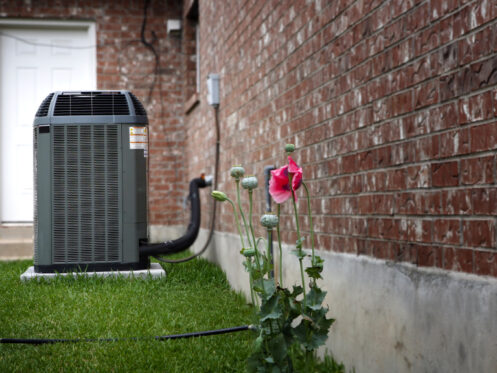Are you concerned about the environmental impact of cooling and/or heating your home? Heating and air conditioning accounts for nearly half of the energy used by a typical home and close to 40% of a home’s carbon emissions. The good news is that it is easy to reduce these numbers and lower your carbon footprint by upgrading to a more efficient, more environmentally friendly HVAC system, and this guide will explain what some of the most eco-friendly HVAC options are.
Most Eco-Friendly Cooling Options
Choosing the most eco-friendly air conditioning option is mostly a matter of comparing energy efficiency ratings. SEER (seasonal energy efficiency ratio) ratings are used to measure the average energy efficiency of central air conditioners, heat pumps, and ductless air mini-split air conditioners. Choosing a unit with the highest SEER rating possible will minimize how much energy you use to cool your home and enable you to lower your carbon footprint.
If your home has a ducted central heating system and you’re looking to add air conditioning, you’re often best to opt for either a central AC unit or heat pump. The same is true if you just need to replace your existing AC system. The primary reason is that a central AC or heat pump will generally be less expensive than a ductless AC system. That said, you can find much more energy-efficient ductless ACs than you can central cooling units.
The most energy-efficient central AC or heat pump currently available is rated at 28 SEER. The majority of ductless ACs are well above 20 SEER, and you can even find systems that are rated as high as 42 SEER. Compared to a 28 SEER central unit, a 42 SEER ductless AC would use over 80% less energy.
Of course, the upfront cost is important unless you’re on an unlimited budget. That means you’ll usually want to search for the most efficient, highest-SEER unit within your price range. In California, any new central AC, heat pump, or ductless AC must be a minimum of 15 SEER. Even if you could only afford say an 18 SEER unit, you still reduce your energy consumption by approximately 21% compared to a 15 SEER unit.
Most Eco-Friendly Options for Heating Your Home
Generally speaking, heat pumps will almost always be the most efficient and eco-friendly heating option in California. Heat pumps are usually at least three times more efficient than any other type of heating. This is especially true in warmer climates since heat pumps function most efficiently and heat most effectively in temperatures of 40 degrees or above.
One major advantage of heat pumps compared to gas furnaces is that heat pumps don’t produce any carbon emissions on their own. However, you also need to consider the environmental impact of producing the electricity needed to power your heat pump. Some parts of the country get the majority of their electricity from coal power plants.
In that case, a heat pump may not be any more environmentally friendly than a gas furnace due to the emissions produced when generating the electricity. In places like California where more of the electricity is produced through renewable sources like wind, solar, and hydroelectric, heat pumps are a much more environmentally friendly choice.
If you’re considering a heat pump, you’ll also want to focus on how efficient it is when heating in addition to its cooling efficiency. This is because some heat pumps heat more efficiently than they cool while others cool more efficiently than they heat. As such, it’s important to strike a balance and find a unit that heats and cools as efficiently as possible.
HSPF (heating seasonal performance factor) ratings tell you how efficiently a heat pump heats on average. These ratings are just a ratio of how much heat the unit produces in BTUs to how many kilowatt-hours of electricity it uses throughout a single heating season. It’s always necessary to look at the average efficiency over an entire heating season since the efficiency fluctuates as the outdoor temperature increases or decreases.
All new heat pumps installed in California must be 8.8 HSPF. Anything above 9 HSPF is considered a high-efficiency unit, but you can find some central heat pumps that are rated as high as 13.5 HSPF. If you were to opt for a 13 HSPF heat pump, it would use around 30% less electricity than a 9 HSPF unit.
Single-Stage, Two-Stage, and Variable-Speed HVAC Systems
Whether a central AC, heat pump, or gas furnace is single-stage, two-stage, or variable-speed also makes a major difference in terms of how environmentally friendly it is. Single-stage systems are the least efficient and thus the least eco-friendly option. The reason is that they only have one power setting and always run at 100% capacity.
Two-stage systems are more efficient since they can slow down to where they only run at between 60% and 70% of their normal capacity. In most cases, a two-stage system will run at this lower capacity at least three-quarters of the time and will consume much less energy when doing so. The system may still need to occasionally run at full power during periods of extreme heat or cold when lots of additional cooling or heating is needed. However, it will always start on the lower setting and only switch to full power if it doesn’t reach the desired temperature after running for a certain period.
Variable-speed systems are the most expensive cooling or heating option, but also by far the most environmentally friendly. This type of system typically has at least several dozen power settings or speeds that it will automatically switch between as needed. Unlike single-stage or two-stage systems that will frequently cycle on and off, variable-speed systems are meant to run constantly except on mild days when almost no heating or cooling is needed. This allows the system to keep the temperature in the home exactly where it should be at all times and also ensures the temperature is consistent throughout every part of the building.
A variable-speed system can slow down to where it only runs at approximately 25% of its full capacity, which greatly reduces its energy consumption. This type of system also uses a variable-speed blower that can slow way down to further reduce how much energy the system uses. Even though a variable-speed system will usually run 24 hours a day in the middle of summer or winter, the amount of energy it uses in a day will still almost always be less than a two-stage system and especially a single-stage system.
Enhancing Home Efficiency With Eco-Friendly HVAC Choices
With more than three decades of experience, Greiner Heating, Air, and Electric is the HVAC company to trust for all of your heating and cooling needs in Solano and Yolo counties. We have a wide selection of central air conditioners, furnaces, heat pumps, and ductless mini-splits, and our team can help you choose the best, most efficient option for your home.
Our professional maintenance and repair services can also help ensure your HVAC system keeps functioning efficiently. We also specialize in home energy audits as well as energy-efficiency upgrades like attic insulation and air sealing. For more information on the ways we can help you improve the efficiency of your HVAC system and your home, contact us today.

